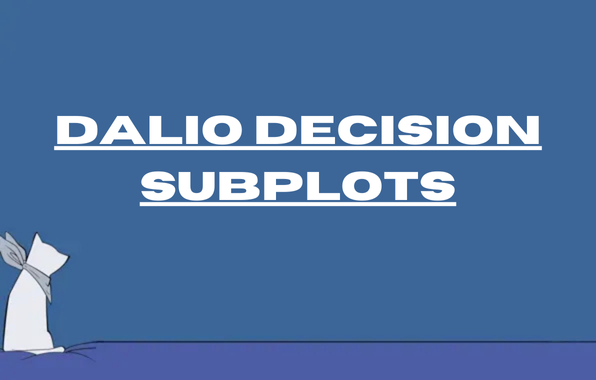In an increasingly complex world, making informed decisions is a skill that separates successful individuals and organizations from the rest. One revolutionary concept, introduced by Ray Dalio, founder of Bridgewater Associates, is Dalio Decision Subplots. These subplots reveal the hidden layers that influence decisions, offering a more comprehensive perspective for smarter, well-rounded choices.
This article delves deep into Dalio Decision Sub plots, their principles, applications, and why they are crucial in today’s decision-making landscape.
What Are Dalio Decision Subplots?
At its essence, Dalio Subplots uncover the secondary factors influencing decisions. While most people focus on the primary narrative—the apparent problem and solution—subplots address the subtle yet powerful influences like emotions, biases, and external pressures that often go unnoticed.
For Dalio, understanding these subplots is essential for navigating decisions with clarity and precision. They offer a deeper view into the unseen dynamics of choices, helping decision-makers evaluate the full picture rather than relying solely on surface-level information.
Core Components of Dalio Decision Sub plots
To grasp the concept better, let’s explore the primary elements that makeup decision subplots:
1. Emotional Biases
Decisions are often swayed by emotions like fear, excitement, or attachment. These biases may cloud judgment and lead to choices driven by feelings rather than facts.
2. Subconscious Assumptions
Beliefs influence many decisions we’re unaware of. For example, preconceived notions about a situation can limit creative problem-solving.
3. External Pressures
Social, cultural, or market forces can subtly push individuals toward decisions that align with external expectations rather than internal goals.
4. Cognitive Shortcuts
Mental heuristics, such as anchoring or availability bias, play a significant role in simplifying decision-making but may lead to oversights or errors.
By addressing these factors, Dalio Subplots empower individuals and organizations to reduce blind spots and make better-informed choices.
The Importance of Dalio Decision Subplots in Decision-Making
Why are Dalio Decision Subplots so impactful?
1. Holistic Understanding
Traditional decision-making often focuses on surface-level information. Subplots bring hidden dynamics to light, ensuring that no critical factor is overlooked.
2. Reducing Errors and Biases
By identifying emotional and cognitive biases, decision-makers can approach situations more objectively, reducing the risk of flawed judgments.
3. Long-Term Sustainability
Decisions based solely on immediate gains may falter over time. Addressing subplots ensures that decisions are sustainable and aligned with long-term objectives.
4. Enhanced Strategic Planning
For businesses, understanding the full spectrum of influences leads to strategies that are not only effective but also resilient in the face of uncertainty.
Dalio’s Principles and Their Connection to Decision Subplots
Ray Dalio’s decision-making philosophy is anchored in two powerful principles:
Radical Truth
Dalio emphasizes embracing reality as it is, not as we wish it to be. This means acknowledging uncomfortable truths about biases, limitations, and unseen factors influencing decisions.
Radical Transparency
Transparency fosters open communication and trust, enabling teams to surface hidden subplots. Sharing diverse perspectives often reveals underlying influences that would otherwise remain hidden.
Together, these principles form the foundation for analyzing and addressing Dalio Decision Subplots, making decisions more accurate and impactful.
How to Identify and Analyze Dalio Decision Sub plots
Recognizing and analyzing decision subplots is an art and a science. Here’s how you can do it effectively:
1. Start with the Main Narrative
Identify the core question or problem driving the decision. For instance, a company deciding to enter a new market might focus on profitability, competition, and market size.
2. Dig Deeper into Subplots
Ask probing questions to uncover hidden influences:
- Are there emotional factors affecting this decision?
- What assumptions are we making?
- Are there external pressures influencing our judgment?
3. Involve Diverse Perspectives
Incorporate input from stakeholders with different viewpoints. This broadens the analysis and reduces the risk of blind spots.
4. Use Data to Validate Insights
While intuition plays a role, data ensures that subplots are grounded in measurable reality. For instance, conducting market research can confirm or challenge initial assumptions.
5. Iterate and Refine
Decision-making is an iterative process. Revisit and reassess subplots as new information becomes available.
Applications of Dalio Decision Subplots
In Business Decision-Making
Dalio’s framework is particularly effective in complex organizational decisions:
- Strategic Planning: Understanding subplots helps companies align strategies with both immediate and long-term goals.
- Risk Management: Addressing hidden factors reduces the likelihood of unforeseen challenges derailing initiatives.
- Innovation: Recognizing subconscious resistance to change fosters a culture of innovation.
In Personal Decisions
Individuals can also apply these principles in everyday life:
- Career Choices: Evaluating emotional desires alongside practical opportunities leads to more balanced decisions.
- Relationships: Identifying biases or assumptions helps navigate personal and professional relationships effectively.
In Financial Investments
Investors, like Dalio, rely on subplots to understand market behaviors, identify trends, and anticipate risks that others may overlook.
Case Study: Dalio Subplots in Action
Let’s consider a real-world example:
Scenario: A company decides whether to adopt a new technology.
Main Narrative
The decision revolves around costs, expected ROI, and implementation timelines.
Subplots Identified
- Emotional Biases: Leadership’s fear of falling behind competitors drives urgency.
- External Influences: Industry trends pressure the company to follow suit, even if the technology doesn’t align with their unique needs.
- Assumptions: The belief that new technology always leads to improved efficiency remains unchallenged.
- Cognitive Biases: Anchoring on competitors’ decisions limits creative solutions.
Outcome
By addressing these subplots, the company uncovers that their workforce lacks the skills to maximize the new technology’s potential. Instead of rushing, they invest in training before adoption, ensuring a smoother transition and higher ROI.
Overcoming Challenges in Recognizing Decision Subplots
Identifying subplots is not always straightforward. Here are some common challenges and how to overcome them:
1. Resistance to Change
People often resist acknowledging biases or hidden influences. Foster an open, non-judgmental environment to encourage honest discussions.
2. Time Constraints
Thoroughly analyzing subplots can be time-intensive. Prioritize the most critical decisions for in-depth analysis.
3. Limited Awareness
Unconscious biases are, by nature, difficult to detect. Regular training on cognitive biases and emotional intelligence can enhance awareness.
Balancing Logic and Intuition
Dalio advocates for a balanced approach that integrates logic and intuition:
Logic
- Use data and analytics to validate assumptions.
- Conduct scenario planning to anticipate potential outcomes.
Intuition
- Reflect on gut feelings that may point to overlooked factors.
- Leverage experience to identify subtle patterns and connections.
The synergy of logic and intuition provides a more holistic view, enabling smarter decisions.
The Long-Term Impact of Dalio Decision Subplots
Implementing Dalio Subplots in decision-making has transformative effects:
- Enhanced Clarity: Decisions are based on a comprehensive understanding of all influencing factors.
- Improved Outcomes: Reduced biases lead to more strategic and sustainable choices.
- Stronger Teams: A culture of transparency and truth fosters trust and collaboration.
By embracing this framework, individuals and organizations can navigate uncertainty with confidence and precision.
Conclusion
Dalio Decision Subplots are a revolutionary tool in the art of decision-making. By uncovering the hidden layers that influence choices, this framework empowers individuals and organizations to make smarter, more strategic decisions.
From addressing biases to fostering transparency, Dalio transforms decision-making into a thoughtful, multi-dimensional process. Whether applied in business, personal life, or investments, understanding and leveraging Dalio Subplots is the key to unlocking better outcomes in an increasingly complex world.
Fixing the M945XMW Code Error Troubleshooting Guide for a Seamless Experience



